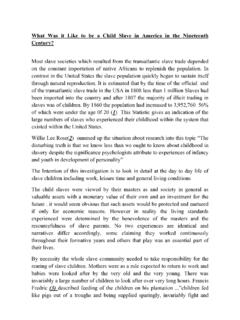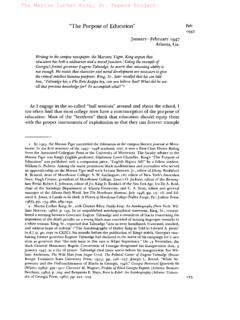Transcription of The National Archives Education Service 1833 Factory Act
1 The National Archives Education Service 1833 Factory Act Did it solve the problems of children in factories? Illustrated London News - ZPER 34/19. 1833 Factory Act Did it solve the problems of children in factories? Introduction Lesson at a Glance The Factory Act Suitable For: KS3 In 1833 the Government passed a Factory Act to improve conditions for children working in factories. Young children were working very long hours in workplaces where conditions were often terrible. The Time Period: basic act was as follows: Empire and Industry no child workers under nine years of age employers must have an age certificate for their child workers 1750-1850. children of 9-13 years to work no more than nine hours a day Curriculum Link: children of 13-18 years to work no more than 12 hours a day children are not to work at night Ideas, political power, two hours schooling each day for children industry and empire: four Factory inspectors appointed to enforce the law Britain, 1745-1901 However, the passing of this act did not mean that the mistreatment of children stopped overnight.
2 Britain as the first industrial nation the Using these sources, investigate how the far the act had solved the impact on society. problems of child labour. Party politics, extension of the franchise and social reform. Contents: Learning Objective: Background: 3. To explain how Teacher's notes: 4. successful the 1833 . Source One: 5. Factory Act was at solving the problems of Source Two: 6. children in factories. Source Two (Transcript): 7. Resources needed: Source Three: 8. Printed sources, pens Source Four: 9. Extension Tasks available: Yes see Teacher's notes This resource was produced using documents from the collections of The National Archives . It can be freely modified and reproduced for use in the classroom only. 2. 1833 Factory Act Did it solve the problems of children in factories? Background As the Industrial Revolution gathered pace thousands of factories sprang up all over the country.
3 There were no laws relating to the running of factories as there had been no need for them before. As a result, dangerous machinery was used that could, and frequently did, cause serious injuries to workers. To add to these dangers, people were required to work incredibly long hours often through the night. Perhaps one of the worst features of this new industrial age was the use of child labour. Very young children worked extremely long hours and could be severely punished for any mistakes. Arriving late for work could lead to a large fine and possibly a beating. Dozing at a machine could result in the accidental loss of a limb. People began to realise how bad these conditions were in many factories and started to campaign for improvements. There was a lot of resistance from Factory owners who felt it would slow down the running of their factories and make their products more expensive.
4 Many people also did not like the government interfering in their lives. Some parents, for instance, needed their children to go out to work from a young age, as they needed the money to help feed the family. Not all Factory owners kept their workers in bad conditions however. Robert Owen, who owned a cotton mill in Lanark, Scotland, built the village of New Lanark for his workers. Here they had access to schools, doctors and there was a house for each family who worked in his mills. By 1833 , the Government passed what was to be the first of many acts dealing with working conditions and hours. At first , there was limited power to enforce these acts but as the century progressed the rules were enforced more strictly. Nonetheless, the hours and working conditions were still very tough by today's standards, and no rules were in place to protect adult male workers.
5 Listed below are details of the legislation (laws) that was introduced to improve working conditions in factories. Date Industry Details of law 1833 Textiles No child workers under nine years Reduced hours for children 9-13 years Two hours schooling each day for children Four Factory inspectors appointed 1844 Textiles Children 8-13 years could work six half-hours a day Reduced hours for women (12) and no night work 1847 Textiles Women and children under 18 years of age could not work more than ten hours a day 1867 All Industries Previous rules applied to workhouses if more than five workers employed 1901 All Industries Minimum age raised to 12 years Useful links: New Lanark Site with photographs and information about Robert Owen's Mill. ( ). 3. 1833 Factory Act Did it solve the problems of children in factories? Teacher's notes This lesson provides pupils with the opportunity to arrive at a conclusion based upon evidence.
6 Pupils could also be encouraged to look at the evidence with a critical approach. Tasks: Source One: This is an extract from a Factory Inspectors Report (1836). Who gave the evidence to the Factory inspector? Work out how many hours (not including breaks), the boys are reported to have worked without stopping Which parts of the new Factory Act have been broken? What does the tone of the letter tell us about what the Factory inspectors thought about the firm Taylor, Ibbotson & Co? Having studied this source, would you be right to conclude that the 1833 Factory Act did nothing to solve the problems of child workers? Explain your answer. Source Two: This is a piece of a document detailing which companies broke the law. What is the most common offence recorded? Work out how much is fined for the different offences By looking at the fines, which offence is regarded as the most serious?
7 How effective was the 1833 Factory Act? Explain your answer. (Hint: is the number of convictions a good or bad sign?). Source Three: This is a photograph of workers in a Factory in 1903. What kind of Factory is the boy working in? How old do you think he is? Write a list of all the dangers you can see in the Factory and what you think could be done to improve them This photograph is from 1903, 70 years after the first Factory Act. Explain whether you think work in the Factory had improved for child workers by this time Is the illustration at the top of this page and this photograph reliable evidence of working conditions in a Factory ? Give reasons for your answer. Suggested activities: You are one of the four Factory inspectors in 1836 trying to enforce the Factory Act. You have seen the evidence of abuse of the the law and you are unhappy with the present system.
8 Write a letter to the Home Secretary suggesting ways to improve the law and better methods of enforcing it. Design a poster to campaign against, or for, child labour in the factories. Have a class debate on child labour with half of the class arguing for child labour. Extension Questions: How reliable is this evidence regarding the success of the 1833 Factory Act? What other evidence would you like see to help you make a decision? 4. 1833 Factory Act Did it solve the problems of children in factories? Source One - Factory Inspectors Report (1836). Extract from a Factory Inspectors report British Parliamentary Papers (1836) No 353. 1. Who gave the evidence to the Factory inspector? 2. Work out how many hours (not including breaks), the boys are reported to have worked without stopping 3. Which parts of the new Factory Act have been broken?
9 4. What does the tone of the letter tell us about what the Factory inspectors thought about the firm Taylor, Ibbotson & Co? 5. Having studied this source, would you be right to conclude that the 1833 Factory Act did nothing to solve the problems of child workers? Explain your answer Transcript My Lord, in the case of Taylor, Ibbotson & Co. I took the evidence from the mouths of the boys themselves. They stated to me that they commenced working on Friday morning, the 27th of May last, at six , and that, with the exception of meal hours and one hour at midnight extra, they did not cease working till four o'clock on Saturday evening, having been two days and a night thus engaged. Believing the case scarcely possible, I asked every boy the same questions, and from each received the same answers. I then went into the house to look at the time book, and in the presence of one of the masters, referred to the cruelty of the case, and stated that I should certainly punish it with all the severity in my power.
10 Mr Rayner, the certificating surgeon of Bastile, was with me at the time. 5. 1833 Factory Act Extract from the Reports of Inspectors of Factories (No 3390). This is a piece of a document detailing which companies broke the law. 1. What is the most common offence recorded? 2. Work out how much is fined for the different offences 3. By looking at the fines, which offence is regarded as the most serious? Source Two - Reports of Inspectors of Factories 1863. 4. How effective was the 1833 Factory Act? Explain your answer. (Hint: is the number of convictions a good or bad sign?). Did it solve the problems of children in factories? 6. 1833 Factory Act Did it solve the problems of children in factories? Source Two - Transcript Transcript of an extract from the Reports of Inspectors of Factories (No 3390). Names of the Names and Magistrates who Amount Amount Addresses of Nature of the Date heard the Case, of of Remarks Persons Offence.















